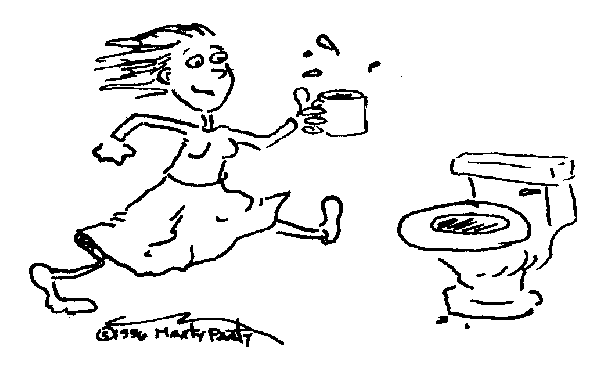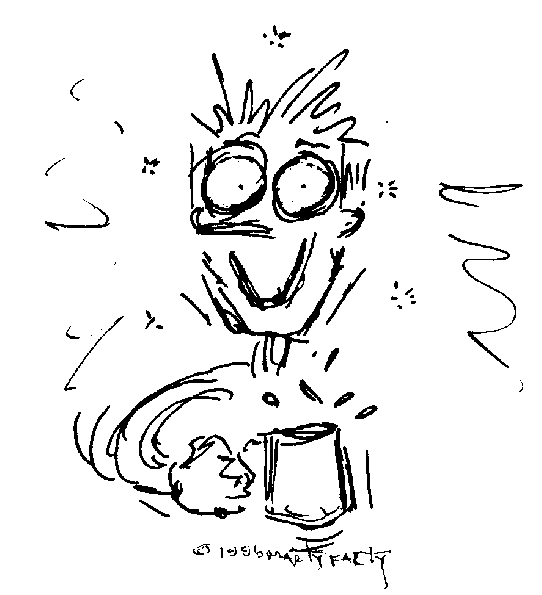

Dear Mad-Dog:
There’s nothing (well, not many things) that I enjoy more than a few cups of coffee in the morning. Unfortunately, they get me going in more ways than I’d like. Why does coffee always send me running for the bathroom? I’d write more but I just finished my second cup and I’ve got to go!
Sadie - a coffee achiever
 Well, Sadie, now that you’ve written to me, at least you’ll have something to read while you go about your scatological business.
Well, Sadie, now that you’ve written to me, at least you’ll have something to read while you go about your scatological business.
Of course, the chicken way out of this would be to merely tell you that caffeine stimulates urine production in the kidneys, an event dubbed “caffeine diuresis.” But you don’t read Mad-Dog for chicken answers (that’s what Dear Abby is for), so grab a big cup o’ joe and settle in...
In the late 18th century, a learned writer named William Corbett penned The Vice of Tea-Drinking claiming that tea was, among other things, “a destroyer of health, an enfeebler of the frame, an engenderer of effeminancy and laziness, a debaucher of youth, and a maker of misery for old age.” You might think that he was talking about daytime TV or aerosol cheese. Chances are that William’s problem was not with tea itself, but with caffeine, the driving force behind a good cup of tea or coffee.
Your pervasive potty problem is probably the result of caffeine as well.
Caffeine, a white, bitter-tasting powder, referred to around the break room of chemistry labs as “1,3,7-trimethylxanthine” has a remarkable range of effects on our fragile human forms. Effects range from perking us up, to increasing fertility, to making our hearts freak out.
Caffeine is a stimulant. You, no doubt, knew this if you have ever had the misfortune to talk to someone who is finishing their third pot of double-strength coffee. These people talk at the rate of several thousand words per minute and use enough hand gestures to necessitate the wearing of safety equipment when standing within 10 feet of them. It is precisely this magical brain stimulating property which makes coffee an indispensable commodity when one is forced to be awake and coherent after a night of excess.
Should you be in the mood for a real eye-opening cup of mud, I humbly offer you the imperial recipe for coffee as decreed by Russia’s Catherine the Great: 1 pound of coffee, 4 cups of water. She was reported to be an anxious person. Go figure.
Caffeine has the remarkable ability to reach almost every part of the body (something we dogs can do with our tongues). It is because of this that caffeine can affect so many of the body’s functions. There are times when this can be advantageous (like when we elect to spend the night before our 7 a.m. physics exam drinking until we forgot our names). There are also times when this is bad (like when we drink 8 cups of coffee before the 7 a.m. physics exam and wet our pants while explaining why E=mc2).
Caffeine is generally taken internally (by way of the mouth and gastrointestinal track) where it quickly enters the bloodstream and is spread to the 42 liters (almost 20 six-packs) of water in our bodies where it begins to get things crankin’. Peak action occurs 30-60 minutes after ingestion. Most of the caffeine has been absorbed into the blood but very little has been metabolized by the liver. Our bodies are equipped with a wide variety of chemicals, juices, and essential vitamins and minerals (just like Frosted Flakes) which regulates all of our internal systems. One chemical, adnosine by name, slows many of our bodily processes (lowering blood pressure and heart rate, causing sleepiness, dilating blood vessels and lots of other stuff). Exactly the opposite of what we expect from a cup of coffee, right?
Our bodies are equipped with a wide variety of chemicals, juices, and essential vitamins and minerals (just like Frosted Flakes) which regulates all of our internal systems. One chemical, adnosine by name, slows many of our bodily processes (lowering blood pressure and heart rate, causing sleepiness, dilating blood vessels and lots of other stuff). Exactly the opposite of what we expect from a cup of coffee, right?
Caffeine is sneaky stuff, though. It has such a similar chemical make-up to adnosine that it binds with adnosine’s receptor sites. Instead of slowing neural firing, caffeine speeds them up (wahoo!). When caffeine is in our systems, we experience exactly the opposite of what is supposed to be happening. We get excited and urine production in the kidneys is increased by 30% for up to 3 hours. If we get too excited, we piddle on the carpet.
Goodness, Mad-Dog. Drinking coffee sounds as though it is fraught with peril. Can it do worse than rendering me less continent? Remember this adage and you will go far in life, “If it’s fun; it’s bad for you.”
Excessive caffeine consumption causes a peculiar syndrome known as “Caffeinism.” Symptoms of caffeinism include frequent urination (caffeine diuresis), agitation, anxiousness, rapid heartbeat, trembling, irritability, loose stools and more.
In fact, my young puppies, excessive caffeine consumption can even be fatal (you sure you want the large coffee?). Ingesting 5,000 milligrams of caffeine is an almost certain way to exit this life. Unfortunately for those of you who wish to go out in this rather odious way, you’ll need to drink 40 cups of strong coffee in a very short time to meet the recommended dosage. High doses of caffeine also induce vomiting, so gagging down those 40 cups may be something of a chore.
On the bright side, I located at least one documented case of death resulting from an enema of very strong (hopefully cold) coffee.
I can think of better ways to go.![]()